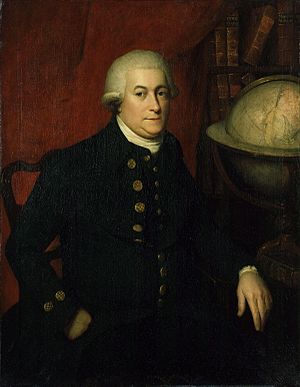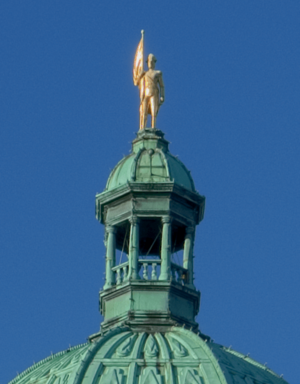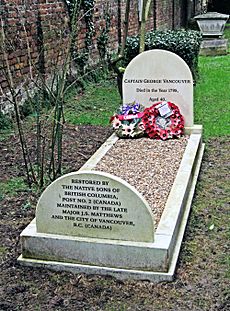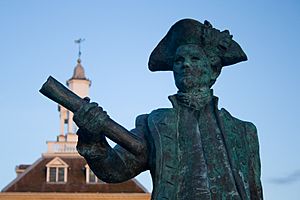George Vancouver facts for kids
Quick facts for kids
George Vancouver
|
|
|---|---|

A portrait from the late 18th century by an unknown artist believed to depict George Vancouver
|
|
| Born | 22 June 1757 King's Lynn, Norfolk, Great Britain |
| Died | 10 May 1798 (aged 40) Petersham, Surrey, Great Britain |
| Allegiance | Great Britain |
| Service/ |
Royal Navy |
| Rank | Captain |
| Commands held | HMS Discovery (Vancouver Expedition, 1791–1795) |
| Signature | |
George Vancouver (born June 22, 1757 – died May 10, 1798) was a British Royal Navy officer. He is famous for his big trip from 1791 to 1795. During this journey, he explored and mapped the northwestern Pacific Coast of North America.
This area includes parts of what are now British Columbia in Canada. It also covers the US states of Alaska, Washington, and Oregon. He also explored the Hawaiian Islands and the southwest coast of Australia. Many places are named after him, like Vancouver Island and the city of Vancouver in British Columbia.
Contents
Early Life and Family History
George Vancouver was born in the seaport town of King's Lynn, England. His birthday was June 22, 1757. He was the youngest of six children. His father, John Jasper Vancouver, was a customs officer from the Netherlands. George came from a respected family.
In 1771, when he was just 13, George Vancouver joined the Royal Navy. He started as a "young gentleman," hoping to become an officer. He sailed on Captain James Cook's second voyage (1772–1775). This trip was to find a southern continent called Terra Australis.
Vancouver also joined Cook's third voyage (1776–1780). This time, he was on the ship HMS Discovery. During this journey, Europeans first saw and explored the Hawaiian Islands.
When he returned to Britain in 1780, Vancouver became a lieutenant. He served on several ships, including HMS Martin and HMS Fame. He even fought in the Battle of the Saintes in 1782.
In the late 1780s, Spain and Britain almost went to war. This was over who owned Nootka Sound on what is now Vancouver Island. Vancouver was given command of the ship Discovery. His mission was to take control of Nootka Sound and map the coasts.
Exciting Explorations

Vancouver's First Big Trip (1791-1792)
Vancouver was tasked with exploring the Pacific Ocean. He left England on April 1, 1791, with two ships: HMS Discovery and HMS Chatham.
In their first year, the ships traveled to Cape Town, Australia, New Zealand, Tahiti, and Hawaii. They collected plant samples and mapped coastlines. Vancouver officially claimed King George Sound in Australia for Britain. This area is now the town of Albany, Western Australia.
Next, they sailed to North America. Vancouver explored the coasts of today's Oregon and Washington. In April 1792, he met American Captain Robert Gray. Soon after, Gray sailed up the Columbia River.
On April 29, 1792, Vancouver entered the Strait of Juan de Fuca. This strait is between Vancouver Island and Washington state. He ordered his crew to map every inlet and outlet on the mainland's west coast, all the way to Alaska. They often used small boats for this dangerous work.
On June 13, 1792, Vancouver became the second European to enter Burrard Inlet. He named it after his friend, Sir Harry Burrard. This inlet is now the main harbor for the City of Vancouver. He spent the next nine days mapping Howe Sound and Jervis Inlet.
On his 35th birthday, June 22, 1792, he returned to West Point Grey. Here, he met a Spanish expedition by surprise. The Spanish explorers already had a rough map of the Strait of Georgia. Vancouver was surprised by this. For three weeks, they worked together to explore the Strait of Georgia.
In August 1792, Vancouver went to Nootka Sound. This was the most important harbor in the region. He was supposed to receive British lands back from the Spanish. The Spanish commander, Juan Francisco Bodega y Quadra, was very friendly. They exchanged maps but couldn't agree on the land. They decided to wait for more instructions. They named the large island where Nootka was located Quadra and Vancouver Island. Later, it became known simply as Vancouver Island.
While at Nootka Sound, Vancouver got Robert Gray's map of the lower Columbia River. Vancouver realized how important this river was. He sent Lieutenant William Robert Broughton to explore it further. Broughton sailed up the Columbia River as far as the Columbia River Gorge. He saw and named Mount Hood.
Vancouver then sailed south along the coast of Spanish Alta California. He visited Native American villages and was welcomed by the Spanish. He spent the winter exploring the Hawaiian Islands.
More Discoveries (1793-1794)
In 1793, Vancouver returned to British Columbia. He sailed further north, just missing another explorer, Alexander Mackenzie. He mapped many islands, including Prince of Wales Island. As the weather got worse, he sailed south to Alta California. He hoped to meet Bodega y Quadra again, but he wasn't there. The Spanish governor would not let a foreign official explore inland. Vancouver noted that the area's defenses were weak. He spent another winter in the Hawaiian Islands.
In 1794, he went to Cook Inlet, the northernmost point of his journey. From there, he sailed south along the coast. His crew mapped many more islands and inlets. He then sailed back to Great Britain around Cape Horn. He returned in September 1795, completing a trip around South America.
Later Life and Challenges
After his long voyages, Vancouver retired to Petersham, near London.
When he returned home, Vancouver faced some problems. A scientist named Archibald Menzies complained about one of his servants. Also, Thomas Pitt, 2nd Baron Camelford, a former crew member Vancouver had sent home for bad behavior, caused trouble for him.
Pitt's friends, including the Prime Minister, criticized Vancouver in the newspapers. Thomas Pitt even challenged Vancouver to a duel. Vancouver refused, saying he couldn't fight a private duel over his official duties. Pitt then attacked Vancouver on a London street. There were many arguments in the press. Vancouver was already sick from his long time at sea, and he died soon after.
Death of a Great Explorer
George Vancouver died quietly on May 10, 1798, at age 40. This was less than three years after finishing his amazing voyages. No official cause of death was recorded, as his medical papers were lost. Some thought he died from kidney failure, while others believed it was a thyroid condition.
His grave is in the churchyard of St Peter's Church, Petersham, in London, England. The Hudson's Bay Company placed a memorial plaque there in 1841. His grave is now a protected historical site.
Vancouver's Lasting Legacy
Mapping the Coasts
Vancouver proved that the famous Northwest Passage did not exist where many thought it would. His maps of the North American northwest coast were incredibly accurate. They were used for coastal navigation for many years.
However, Vancouver did not discover two very large and important rivers: the Fraser River and the Columbia River. He also missed the Skeena River in northern British Columbia. He later learned about the Columbia River from Captain Robert Gray. But neither the Columbia nor the Fraser River appeared on Vancouver's final maps.
It's hard to imagine how Vancouver missed the Fraser River. But much of the river's delta was flooded in summer. This made it hard for him to see its large channels as he sailed by. Spanish explorers before him also missed the Fraser River, even though they knew a big river was nearby from its muddy water.
Relations with Indigenous Peoples
Vancouver generally had good relationships with both Indigenous peoples and European traders. His journals show that he cared about the native populations he met.
He also wrote in his journals that he disliked traders who gave guns to Indigenous people.
Vancouver's interactions with Indigenous groups were mostly peaceful. There were a few difficult moments at the end of his last trip. The most serious was a fight with the Tlingit people in Alaska in 1794. But these were rare events during his exploration of the US and Canadian Northwest coast.
Despite a long history of war between Britain and Spain, Vancouver got along very well with his Spanish counterparts. He even hosted a Spanish sea captain on his ship Discovery during his 1792 trip.
Interesting Facts About George Vancouver
- The name Vancouver comes from Coevorden, a town in the Netherlands. It means "from Coevorden."
- George Vancouver named a point in Alaska Point Couverden. He did this to honor his family's hometown of Coevorden.
- Vancouver named many places after his officers, friends, and his ship Discovery. Some examples include:
- Mount Baker – named after Joseph Baker, who first saw it.
- Mount St. Helens – named after his friend, Alleyne Fitzherbert.
- Puget Sound – named after Peter Puget, who explored it.
- Mount Rainier – named after his friend, Peter Rainier.
- Whidbey Island – named after naval engineer Joseph Whidbey.
- Discovery Passage, Discovery Island, and Discovery Bay – all named after his ship, Discovery.
- Canada Post made a special stamp in 2007 to celebrate Vancouver's 250th birthday. It shows Vancouver from behind, looking at a mountainous coast.
Places Named After George Vancouver
Ships and Cadet Units
- HMCS Vancouver is a Canadian Navy ship. (Named for the city, which is named for the man.)
- TS Vancouver, an Australian Navy Cadets unit.
- 47 RCSCC CAPTAIN VANCOUVER, a Royal Canadian Sea Cadets unit.
Places
Many places around the world are named after George Vancouver:
Australia
- Vancouver Peninsula, Cape Vancouver, and Vancouver Breakers in King George Sound, Western Australia.
Canada
- Mount Vancouver, a tall mountain in Yukon and Alaska.
- Vancouver, British Columbia, a major city in Canada.
- Vancouver Bay, British Columbia, in Jervis Inlet.
- Vancouver Island, a large island off the coast of British Columbia.
New Zealand
- Mount Vancouver, a tall mountain in New Zealand.
- Vancouver Arm of Breaksea Sound, in New Zealand.
United Kingdom
- Vancouver Road in Ham, London, near where he is buried.
United States
- Vancouver, Washington, a city in southwest Washington state.
- Fort Vancouver, an old trading post.
Memorials


- Statues of Vancouver are in his hometown of King's Lynn, outside Vancouver City Hall, and on top of the British Columbia Parliament Buildings.
- The Vancouver Quarter Shopping Centre in King's Lynn is named after him.
- Canada Post has issued several stamps honoring Vancouver and his voyages.
- Gate to the Northwest Passage, a statue by Alan Chung Hung, is in Vanier Park in Vancouver.
- The George Vancouver Rose is a type of rose named after him.
- A train unit in the UK was named Captain George Vancouver.
- A monument in North Kihei, Maui, Hawaii, remembers Vancouver's gift of coffee and vegetables to the islands.
Vancouver's Writings
The British Navy asked Vancouver to write about his voyage. He started writing in 1796. When he died, his brother John finished the book. It was called A Voyage of Discovery to the North Pacific Ocean, and Round the World. It was published in 1798. A newer version was published in 1984, called The Voyage of George Vancouver 1791–1795.
See also
 In Spanish: George Vancouver para niños
In Spanish: George Vancouver para niños
- European and American voyages of scientific exploration



